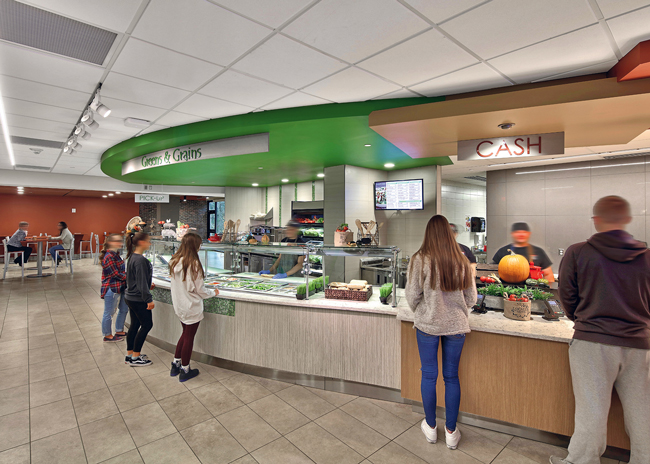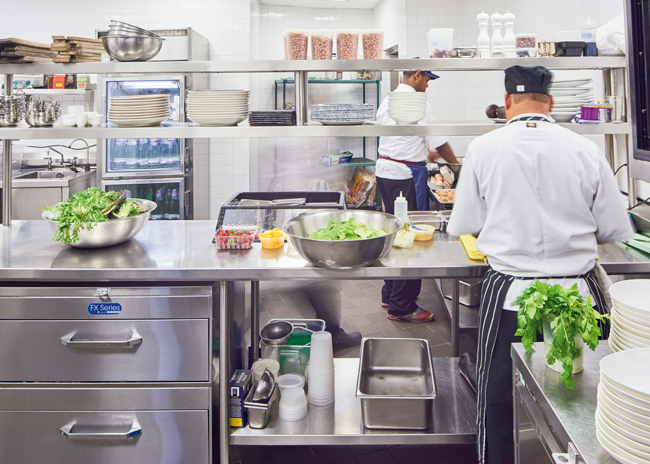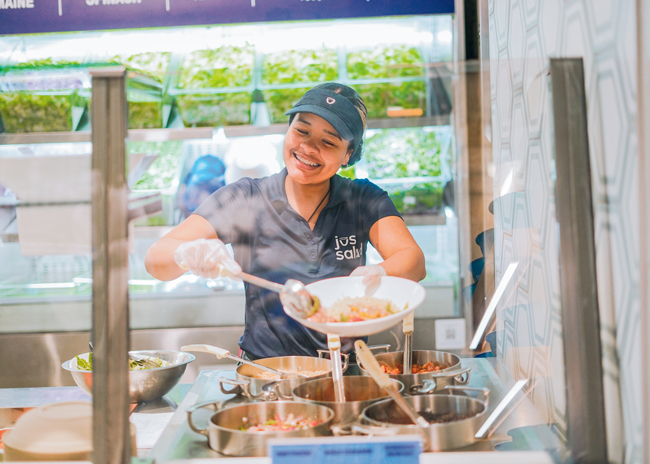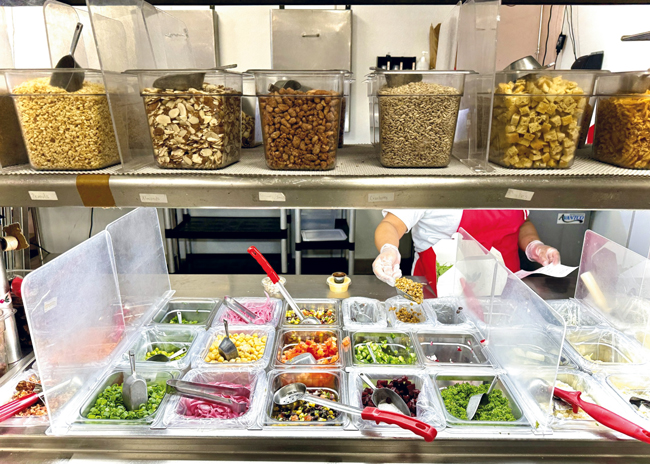Functional designs that keep ingredients as fresh as possible depend on having the proper tools and equipment in close proximity.
Whether located in the front or back of the house, or in a self-serve bar format, successful salad station design puts an emphasis on freshness, accessibility and efficiency. “It’s about utilizing the space as best as possible, with adequate room to achieve what needs to be done,” says Nick Morales, senior project manager/foodservice design consultant, Cini-Little, based in Washington, D.C.
Keeping ingredients as fresh as possible is the overall goal since this speaks to salad quality. “Critical is refrigeration so produce temperatures remain below 41 degrees,” says Brent Hall, principal and president, Clevenger Associates, located in Elma, Wash. “This can be harder to achieve with a [self-serve] salad bar.”
 Designing a salad station that can accommodate different cuisines creates built-in flexibility and expands the definition of the salad bar. Photo courtesy of Culinary Advisors
Designing a salad station that can accommodate different cuisines creates built-in flexibility and expands the definition of the salad bar. Photo courtesy of Culinary Advisors
Key Components and Elements
The equipment lineup for salad prep stations tends to be more cut-and-dried than other functional areas as there is typically no cooking involved. The menu will determine specific equipment needs. “The main equipment needs are typically a reach-in refrigerator, worktable with a sink incorporated, wall shelves to best utilize the space and a trash receptacle for scraps,” says Morales.
For salad bars, the requirements are different, since state and local regulations often come into play. “The most critical component in this case is the relationship of the food shields to the counter and cold wells,” says Laura Lentz, design principal, Culinary Advisors, Phoenix, Md. “NSF revamped these requirements in 2017.” Food shields must be certified to NSF/ANSI Class 2 to meet regulatory guidelines. “We used to have combo adjustable guards for self- and full-serve salad stations, but new requirements affected that,” Lentz notes.
Ergonomics comes into play more when a station is self-serve or full-serve in the front of the house. “When designing salad bars, it’s watching for reach,” Lentz says. “We have requirements of setback from the counter edge and where wells are placed. And we ensure there are proper clearances.”
Lentz has faced issues in the past with counter depth conforming to recent NSF requirements. “For both self- and full-service, it’s important to get the dimensions just right,” she says. In a front-of-the-house, full-serve operation she worked with, employees couldn’t reach far enough to hand customers their salads, which meant getting more specific about where and how to place food shields. “This also is an issue for salad stations that convert from full- to self-serve at different dayparts,” she adds.
Along with assessing reach, proper merchandising is a consideration with front-of-the-house salad stations. “Because those choosing salads may be more wellness minded, the right type of cold display for this food is critical,” Lentz says. “Equipment should display food in the best way possible, yet it needs to be recessed 3 inches due to regulations.”
In addition to the salad bar’s length and location, lighting plays a critical role here, too, as it highlights food appropriately for marketing purposes. The amount of refrigeration is also crucial and dependent on the operation’s menu and volume. “We’ve seen it where a client wants to include more salad toppings, but there aren’t enough cold pans to accommodate that,” Hall says. “In this case, pan sizes are reduced, and more have to be stocked.”
Looking at the type of salad station, and whether it’s full- or self-serve or a combination, is another factor. During the days of COVID-19 and even afterward, many foodservice operators steered away from self-serve bars.
“Many corporate dining clients, in particular, moved away from self-serve salad bars,” Hall notes. “One of the critical things we did when they were undecided whether they were bringing these back is to put in flexible food shields that could work for full- and self-serve salad stations.”
But the tides have turned—Hall estimates that larger corporate dining operations garner 60% of sales from self-serve salad bars. “For this reason, these clients like to have a robust station with lots of offerings,” Hall says. “When that comes into play, they offer proteins, or what we call toppers, such as chicken and steak.”
When an operator offers more options at the salad bar, the configuration of this space becomes even more critical. “We format it with the cold options first, followed by toppers, then dressings and ending with dry ingredients like croutons, dried cranberries and sunflower seeds,” Hall says. “The order of the layout is critical to how salads are built.”
If soup is part of the equation, the self-serve bar format can get even trickier. “It is very hard to ladle soup into a bowl when there’s a food shield,” Hall says. “We have to talk it through with the client and look at the length of the ladle to make sure it doesn’t hit the shield.” He adds that one way to circumvent food shields is by using hinged covers on soup wells.
 Keeping ingredients as fresh as possible is always a primary goal when it comes to salad stations, which in turn makes refrigeration a critical component of design. Photo courtesy of Cini-Little, photo by Nhuri Bashir
Keeping ingredients as fresh as possible is always a primary goal when it comes to salad stations, which in turn makes refrigeration a critical component of design. Photo courtesy of Cini-Little, photo by Nhuri Bashir
Additional Considerations
Along with the equipment lineup, operators should weigh some other considerations with salad station design. The menu, as well as the volume, determine the necessary refrigeration capacity. Its location depends on restocking needs, as well.
“It’s beneficial to have a salad station by a walk-in or refrigerator for long-term storage and backup items,” Morales says. “In the front of house, an accessible reach-in is needed, so employees don’t need to walk through the kitchen constantly to replenish.”
The accessibility of a sink is not always top of mind, but it is important to the station’s functionality. “Many times, I’ve seen that this is missed, but it’s needed to rinse off knives and cutting boards,” Morales explains.
Hall emphasizes that, in the back of the house, the design should include appropriate storage space for utensils. Addressing challenges with rising costs, full-serve salad station designs are becoming more versatile to pull double duty.
“A flexible salad station design can accommodate different cuisines,” Lentz says. “As menus have become smaller, and labor issues prevail, I’m designing more combination stations with salad and sandwiches; this way, one person can cover both stations during slower periods.”
In front-of-the-house salad stations and self-serve salad bars, presentation is key, since guests want to see the product. In both cases, the salad bar length is dependent on the number and type of toppings. “This should be sized correctly from the get-go, so operators are not trying to squeeze more out of the space,” Lentz says. “This is especially true for self-serve bars that are centered in the space or a double-sided island.”
In a self-serve situation, whether single-serve or double-sided, Lentz will assess the station’s popularity to determine volume. “I get it down to a count, and that becomes a queuing diagram for me,” she says. “I look at how many people will be there at peak meal periods flowing through, and whether a double-sided salad bar is needed for the volume and can be accommodated in the space.” She recommends initially sizing the bar bigger, as it is easier to downsize the space if necessary.
The logistics of building the salad then come into play. “Operators need to think about the beginning of the salad bar and whether plates are being handed out by employees or stored on a plate shelf or dispenser,” Lentz says.
Looking at whether permanent ware, disposables or a combination of the two will be included also impacts the design. “Disposables are becoming more common at salad bars, since many are running through at lunch to grab a meal that will be healthy and fresh,” Lentz says.
The tail end of a self-serve salad bar includes dressings, and operators can choose from a variety of format options. “Sometimes there are ladled dressings in open containers, but this can cause a mess,” Lentz says. “Another option is using carafes for dressings, which curtails the breath guard length.”
Food cost also comes into play with salad station design in the front of the house. “We like to make space for healthy items and less costly ingredients at the beginning of the line, then put hot proteins like chicken and steamed salmon near the end,” Lentz says. “If we’re dividing the cold items into thirds, I format the station to include one-third lettuce or greens and two-thirds toppings and other cold items, with hot wells at the end for warm proteins.”
Dressings and other toppings generally sit at the end of the line. “Dressings are adjacent to an area of open counter for bread, fresh rolls and sometimes dry salad toppings,” Lentz says. “Then, there is an area for silverware and napkins prior to the POS station.”
Location and size are also factors with POS areas. “Now with self-checkout, we have to factor in where and how customers will pay,” Lentz says. “Will we need additional space to put the salad down when paying or a scale for weighing at checkout?”
The goal is to move through the POS area as quickly as possible. “We had a client flipping from having a cashier to self-checkout, and there was an issue because it was the only location with scales,” Lentz says. “We realized the transaction time was so long to process that it caused a bottleneck.” Consequently, this station’s design needs to factor in transaction time to keep traffic moving.
“The trick is that salad bars may be the only self-checkout station needing scales, so these become an important aspect of the design,” Lentz adds.
 Presentation is key for customer-facing salad stations; guests want to see the product.
Presentation is key for customer-facing salad stations; guests want to see the product.
Logistics and the Latest Equipment
Because salad stations tend to have a flurry of activity, whether in the back of the house with food prep, front of the house with combining ingredients or self-serve bar with customers making their own creations, location is critical to a successful design.
The salad station layout tends to be tighter in the kitchen versus the front of the house, since ingredients are not on display for customer viewing in the back, Hall says. “In kitchens, refrigerated cold and backup refrigerated storage is below the worktable,” he adds.
Depending on the offerings, there may be additional equipment requirements. “For example, a salad station can include bread carving, which would require a hot holding cabinet below for warming,” Hall says. “There also may be hot, frozen and cold pans that can be interchanged.”
Accessorizing in the front of the house can add to a self-serve salad station’s visual appeal. “I love accessorizing with cold templates for types of wares that create nicer displays than hotel pans,” Lentz says. “However, the jury is still out on frost tops; these create beautiful displays but require a higher level of maintenance.”
In addition to the front of the house and salad bar both being aesthetically pleasing, the space’s temperature should be assessed. “With these designs, operators need to consider noise from the refrigeration’s compressors, as well as the heat these generate, to determine if remote refrigeration is appropriate,” Lentz says. “This will make the design less flexible for future changes but create a nicer, quieter presentation.”
Other factors with logistics include placing drains in accessible areas for easier cleaning, as well as assessing utility needs and placement of equipment switches. “Many times, I’ve seen projects where switches are buried in the unit,” Lentz says. “You want to be able to easily turn units on and off, which will provide a longer service life.”
Another common mistake is thinking spacing and overhangs don’t matter with salad bars. “If there is a space where reach is a common client concern, it’s in the salad bar,” Lentz says.
In all salad stations, allergens are a consideration too. A decision should be made whether to combine these foods in the main footprint, segregate the ingredients or take these foods out of the mix completely. “There has been a movement for allergen-friendly salad bars in higher education settings, but it is now filtering up,” Lentz says.
Looking ahead, robotics may be more of a factor in the future and help curtail labor, but this is not yet widespread for salad production.

Customization-Centric Salad Concept
Launched in 2021 in Santa Clara, Calif., The Good Salad began as an experiment in customizable salads. In 2023, the concept expanded, adding locations in Los Altos and Palo Alto, and created a commissary kitchen that acts as the restaurants’ central prep facility as well as catering fulfillment.
“We offer 40-plus ingredients, which translates into trillions of combinations,” says Sanad Al Souz, founder and CEO. “The focus is on operational efficiency, and the salad station is a key component of that.”
Guests order most of its salads to-go, and 9 out of 10 are customized. Popular ingredients are chicken, avocado, green onion and cucumber.
The Good Salad has two back-of-the house stations — one for the salad base and another for toppings. The base station is smaller and holds a mix of lettuce types and dressings.
“The person assigned to this station is responsible for ‘basing’ the salads,” Al Souz says. “They would fill the salad box with greens and dressing for each incoming order, and then pass it off to the toppings station, where both cold and dry are scooped.”
Al Souz says size is the most important consideration with salad station design, as these spaces need to accommodate a sufficient number of items. They should take into account usable sides or accessibility, too. “Most kitchen salad stations are designed to be placed against the wall, so only one person can use them at a time (or per section),” he says. “We found that salad stations that can be accessed from both sides offer significantly more throughput.”
The Good Salad’s largest salad station can accommodate three people at a time — two as salad makers and one who serves as an inspector who closes boxes and adds labels. Appropriate storage is also key in designing these stations.
“Having additional shelves either built into the station or that can be added offers a huge benefit, especially for small spaces,” Al Souz notes. Lights were recently added to better illuminate salad toppings. “We also added shields to prevent cross-contamination between ingredients,” Al Souz says.



